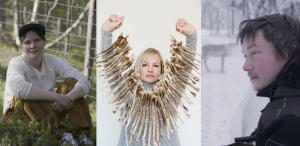Office for Contemporary Art Norway (OCA) announces live from the Sámi Parliament in Kárášjohka, in the Norwegian part of Sápmi, that Sámi artists Pauliina Feodoroff, Máret Ánne Sara and Anders Sunna will represent Sápmi, their Sámi homeland, and transform the Nordic Pavilion into the Sámi Pavilion at the 59th Venice Biennale in 2022. This is an historic moment: the first time that Sámi artists are presented exclusively in a national pavilion at the Biennale Arte, and the first time the Sámi are recognised as a nation in a pavilion bearing their name.
By appointing Feodoroff, Sara and Sunna to transform the pavilion, OCA Norway—2022 commissioner of the Nordic Pavilion—aims to draw attention to the excellence of these Sámi artists, as well as the international relevance of their individual and collective histories. Their art emphasises the urgent situation experienced today by many Sámi—and other Indigenous people worldwide—concerning self-determination, deforestation, land and water governance; and specifically for these Sámi artists, the struggle to maintain the reindeer herding and fishing that are central to their existence. The artists reflect upon these concerns by drawing from Sámi ways of being and knowing, producing work of great beauty and power. This makes them extraordinary within the art world of today.
The Sámi are the Indigenous people of the Scandinavian Peninsula and large parts of the Kola Peninsula, which today is divided between Sweden, Norway, Finland and Russia. Sápmi is the Sámi people’s own name for their homeland. The transformation of the Nordic Pavilion into the Sámi Pavilion is an act of Indigenous sovereignty that highlights the relationship of the artists to their homeland Sápmi, an area that pre-dates the concept of the Nordic region, and presents a pavilion that encompasses all of the lands and people of what was originally a borderless region. It is a symbolic reversal of colonial claims that have sought to erase Sámi land and culture.
Katya García-Antón, Director of the Office for Contemporary Art Norway, lead commissioner of the Nordic Pavilion, comments: “The global pandemic, the impact of climate change and worldwide calls for decolonisation are leading us all to focus on alternative possibilities for our future and that of our planet. At this pivotal moment, it is vital to consider Indigenous ways of relating to the environment and to each other. The artworks of Feodoroff, Sara and Sunna in the Sámi Pavilion will present compelling visions of how these relationships operate, from a Sámi perspective. As leading voices of their generation, these artists’ works counter the impact of colonialism upon their lives and, in so doing, connect with the experiences shared by so many people, Indigenous and non-Indigenous, in our world today.”
The exhibition in the Sámi Pavilion is curated by a group consisting of Sámi scholar Liisa-Rávná Finbog, Sámi nature guardian Beaska Niillas and OCA’s director Katya García-Antón; assisted by Liv Brissach (OCA Project Officer) and Raisa Porsanger (Sámi artist, and OCA Project Officer).
The project also benefits from an international group of advisors consisting of Wiradjuri interdisciplinary artist Brook Andrew (Artistic Director NIRIN, Sydney Biennial, Australia) and Anishinaabe curator (Art Gallery of Ontario, Turtle Island/Canada), artist and educator Wanda Nanibush.
Artists:
Pauliina Feodoroff (b. 1977) is a Skolt Sámi theatre director, artist and nature guardian from Keväjäuʹrr, in the Finnish part of Sápmi, and Suõʹnnjel, in the Russian part of Sápmi. Feodoroff has advocated for Sámi water and land rights in her previous role as President of the Saami Council and as an artist working to combine various fields of knowledge at the intersection of ecological conservation, theatre and film. In 2018 her cross-disciplinary project What Form(s) Can an Atonement Take used Sámi land-care practices, bringing together local and scientific knowledge to protect the waters and surrounding lands of the Njâuddam river in the Finnish part of Sápmi.
Máret Ánne Sara (b. 1983) is a Northern Sámi artist from Guovdageaidnu in the Norwegian part of Sápmi. She is known for experimenting with a range of materials and approaches that make visible the political and social issues affecting the Sámi people. Her works are often made from materials deriving from the sustainable practice of her reindeer-herding family, including reindeer bones, hides and intestines. Her installation Pile o’ Sápmi, composed of 400 reindeer skulls and legal documents, was showcased at documenta 14 in Kassel, 2017. The installation was recently purchased by the National Museum, Norway.
Anders Sunna (b. 1985) is a Northern Sámi artist from Kieksiäisvaara, in the Swedish part of Sápmi. Sunna’s politically charged artworks narrate the history of the oppression of the Sámi people and specifically address his family’s five-decade long struggle for their land rights as forest reindeer herders. With powerful imagery and political satire, his paintings, graffiti, sculptures and installations depict how abuse of authority and power lead to the exploitation of land and natural resources, forced displacement, and racial persecution of Sámi people. Sunna was recently commissioned to make a site-specific mural for the 22nd Biennale of Sydney, NIRIN, 2020. The work made connections between the colonial project of Captain Cook and the issues faced in Sápmi.
The Nordic Pavilion
The Nordic Pavilion, designed by Norwegian architect Sverre Fehn, was completed in 1962 and has since been a space for collaboration between three nations: Finland, Norway and Sweden. Exhibitions in the Nordic Pavilion for the International Art Exhibition of La Biennale di Venezia are commissioned by the Office of Contemporary Art Norway, Moderna Museet, Sweden and Kiasma Finnish National Gallery, Finland, who each take turns as lead commissioner of the Nordic Pavilion.
Commissioners
The 2022 Pavilion is commissioned by Office for Contemporary Art Norway (OCA). The co-commissioners are Gitte Ørskou, Director of the Moderna Museet in Stockholm, Sweden and Leevi Haapala, Director of Kiasma Finnish National Gallery in Helsinki, Finland.


